Viséan
The Visean, Viséan or Visian is an age in the ICS geologic timescale or a stage in the stratigraphic column. It is the second stage of the Mississippian, the lower subsystem of the Carboniferous. The Visean lasted from 346.7 to 330.9 Ma.[1] It follows the Tournaisian age/stage and is followed by the Serpukhovian age/stage.
| Viséan | |
|---|---|
| 346.7 ± 0.4 – 330.9 ± 0.2 Ma | |
| Chronology | |
Key events in the Carboniferous -360 — – -355 — – -350 — – -345 — – -340 — – -335 — – -330 — – -325 — – -320 — – -315 — – -310 — – -305 — – -300 — – Key events of the Carboniferous Period Axis scale: millions of years ago | |
| Etymology | |
| Name formality | Formal |
| Alternate spelling(s) | Visean, Visian |
| Usage information | |
| Celestial body | Earth |
| Regional usage | Global (ICS) |
| Time scale(s) used | ICS Time Scale |
| Definition | |
| Chronological unit | Age |
| Stratigraphic unit | Stage |
| Time span formality | Formal |
| Lower boundary definition | FAD of the Benthic Foraminifer Eoparastaffella simplex |
| Lower boundary GSSP | Pengchong Section, Guangxi, China 24.4333°N 109.4500°E |
| GSSP ratified | 2008 |
| Upper boundary definition | Not formally defined |
| Upper boundary definition candidates | FAD of the Conodont Lochriea ziegleri |
| Upper boundary GSSP candidate section(s) |
|
Name and definitions
The Viséan stage was introduced by Belgian geologist André Dumont in 1832. Dumont named this stage after the city of Visé in the Belgian province of Liège. Before being used as an international stage, the Visean stage was part of the (West) European regional geologic time scale, in which it followed the Tournaisian stage and is followed by the Namurian stage. In the North American regional scale, the Visean stage correlates with the upper Osagean, the Meramecian and lower Chesterian stages. In the Chinese regional time scale, it correlates with the lower and middle Tatangian series.[2]
The base of the Viséan stage is at the first appearance of the fusulinid species Eoparastaffella simplex (morphotype 1/morphotype 2). The type locality for the stage base used to be in a road section below the castle of Dinant in Belgium, but this type locality proved to be insufficient for the purpose of stratigraphic correlation.[2] A GSSP has been proposed in the Luzhai Formation near Penchong in the Chinese province of Guanxi.[3] The top (the base of the Serpukhovian and Namurian) is laid at the first appearance of the conodont Lochriea ziegleri,[4] or at the base of the biozone of goniatite Cravenoceras leion.
Tetrapods
One of the tetrapods that lived during the Visean age was Westlothiana, a reptile-like amphibian.
Biostratigraphy
The Visean contains four conodont biozones:
- Lochriea nodosa Zone
- Lochriea mononodosa Zone
- Gnathodus bilineatus Zone
- Gnathodus texanus Zone
In British stratigraphy, the Visean is subdivided into five substages. These are from bottom to top: Chadian (the lower part of this substage falls in the Tournaisian), Arundian, Holkerian, Asbian and Brigantian.[5]
Viséan life
Cartilaginous fish
| Cartilaginous fish of the Viséan | ||||
|---|---|---|---|---|
| Taxa | Presence | Location | Description | Images |
| Stethacanthus | ||||
Tetrapodomorphs
| Tetrapodomorphs of the Viséan | ||||
|---|---|---|---|---|
| Taxa | Presence | Location | Description | Images |
| Crassigyrinus | Viséan - Serpukhovian | Scotland | Crassigyrinus had a streamlined body, up to 2 meters in length, with tiny and virtually useless limbs, implying that the animal was almost completely aquatic. |  |
| Deltaherpeton | Asbian | Iowa | A colosteid | |
| Eucritta | Scotland | A baphetoid. Eucritta's mosaic possession of characters seen in baphetids, early reptiliomorphs, and temnospondyls suggests that these groups diverged in the Carboniferous rather than earlier, in the Devonian. | 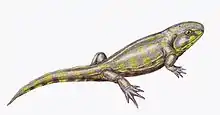 | |
| Greererpeton | late Viséan | North America | A colosteid | 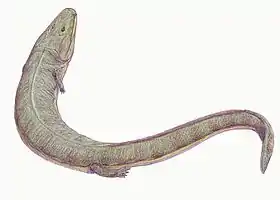 |
| Ossinodus | Middle Visean | Queensland, Australia | Possibly a basal whatcheeriid, Ossinodus is one of the first large tetrapods discovered to have existed during Romer's gap and the oldest tetrapod fossil with a preserved injury. | 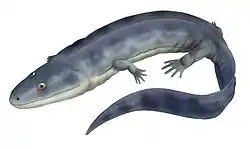 |
| Pholidogaster | Brigantian | Scotland | A colosteid |  |
| Rhizodus | Brigantian | UK | A genus of gigantic rhizodontid fish. As one of the largest freshwater fish to have ever lived, Rhizodus was an apex predator in its environment that fed on small to medium-sized amphibians, using its teeth to kill prey and rip it into digestible sizes rather than swallowing prey whole like other, smaller-toothed sarcopterygians. |  |
| Sigournea | Asbian | Iowa | A stem-tetrapod known from a single lower jaw, a close relative of Occidens portlocki and possibly a baphetoid. | |
Spathicephalus
|
Asbian | Scotland | A species of baphetoid stem-tetrapod | |
| Whatcheeria | Asbian | Iowa | A whatcheeriid | |
Temnospondyli
| Temnospondyls of the Viséan | ||||
|---|---|---|---|---|
| Taxa | Presence | Location | Description | Images |
| Balanerpeton | Scotland | A genus of temnospondyl amphibian |  | |
Reptiliomorphs
| Reptiliomorphs of the Viséan | ||||
|---|---|---|---|---|
| Taxa | Presence | Location | Description | Images |
| Casineria | Asbian | Cheese Bay, Scotland | The earliest known amniote, also likely to be among the first amniotes in the biological sense | 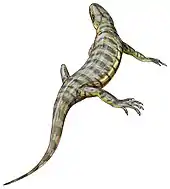 |
| Eldeceeon | Brigantian | East Kirkton Quarry, West Lothian, Scotland, | Eldeceeon is thought to be closely related to embolomeres, but it has several distinguishing features | 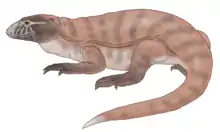 |
| Silvanerpeton | Brigantian | East Kirkton Quarry, West Lothian, Scotland, | It's believed to have been an advanced reptile-like amphibian, close to the origin of amniotes. |  |
| Westlothiana | Brigantian | East Kirkton Quarry, West Lothian, Scotland, | Its phylogenetic placement has varied from basal amniote, to a basal lepospondyl, therefore, Westlothiana may actually be closer to modern amphibians than to amniotes, although still close to both. | |
Arthropods
| Arthropods of the Viséan | ||||
|---|---|---|---|---|
| Taxa | Presence | Location | Description | Images |
| Arthropleura | Scotland | Tracks | ||
| Pulmonoscorpius | East Kirkton Limestone Formation, Scotland | |||
References
- "International Chronostratigraphic Chart". International Commission on Stratigraphy. Retrieved 9 December 2012.
- Menning, M.; Alekseev, A.S.; Chuvashov, B.I.; Davydov, V.I.; Devuyst, F.-X.; Forke, H.C.; Grunt, T.A.; Hance, L.; Heckel, P.H.; Izokh, N.G.; Jin, Y.-G.; Jones, P.J.; Kotlyar, G.V.; Kozur, H.W.; Nemyrovska, T.I.; Schneider, J.W.; Wang, X.-D.; Weddige, K.; Weyer, D. & Work, D.M.; 2006: Global time scale and regional stratigraphic reference scales of Central and West Europe, East Europe, Tethys, South China, and North America as used in the Devonian–Carboniferous–Permian Correlation Chart 2003 (DCP 2003), Palaeogeography, Palaeoclimatology, Palaeoecology 240(1-2): pp 318–372.
- Devuyst, F.X.; Hance, L.; Hou, H.-F.; Wu, X.; Tian, S.; Coen, M. & Sevastopulo, G.; 2003: A proposed Global Stratotype Section and Point for the base of the Visean Stage (Carboniferous): the Pengchong section, Guangxi, South China, Episodes 26(2), pp 105–115.
- Nemyrovska, T.I.; 2005: Late Visean/early Serpukhovian conodont succession from the Triollo section, Palencia (Cantabrian Mountains, Spain), Scr. Geol. 129, pp 13–89.
- Heckel, P.H. & Clayton, G.; 2006: The Carboniferous system, use of the new official names for the subsystems, series and stages, Geologica Acta 4(3), pp 403–407.
Further reading
- Dumont, A.H.; 1832: Mémoire sur la constitution géologique de la province de Liège, Mémoires couronnés par l'Académie Royale des Sciences et Belles-Lettres de Bruxelles 8(3), VII. (in French)
External links
- Upper and lower time scales for the Carboniferous at the website of the Norwegian network of offshore records of geology and stratigraphy.
- Visean, Geowhen Database
- The Viséan age, www.palaeos.com